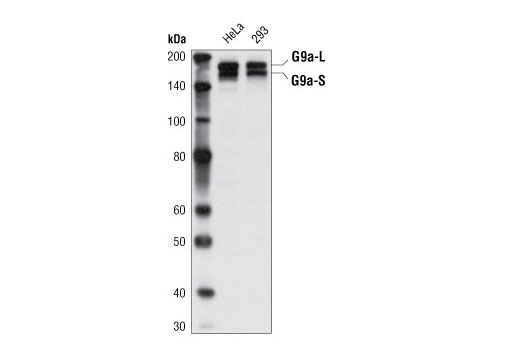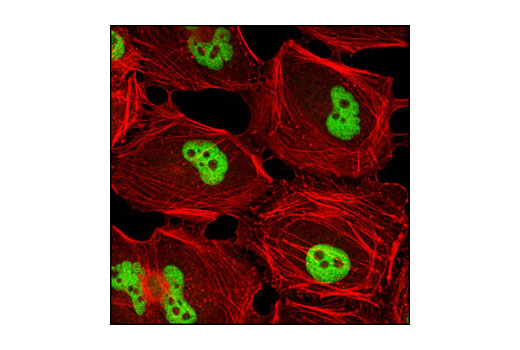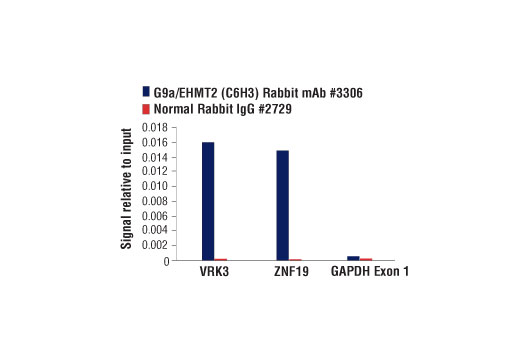WB, IF-IC, ChIP
H M R Mk
Endogenous
160,180
Rabbit IgG
#Q96KQ7
10919
Product Information
Product Usage Information
For optimal ChIP results, use 10 μl of antibody and 10 μg of chromatin (approximately 4 x 106 cells) per IP. This antibody has been validated using SimpleChIP® Enzymatic Chromatin IP Kits.
| Application | Dilution |
|---|---|
| Western Blotting | 1:1000 |
| Immunofluorescence (Immunocytochemistry) | 1:50 |
| Chromatin IP | 1:100 |
Storage
Specificity / Sensitivity
Species Reactivity:
Human, Mouse, Rat, Monkey
Species predicted to react based on 100% sequence homology
The antigen sequence used to produce this antibody shares
100% sequence homology with the species listed here, but
reactivity has not been tested or confirmed to work by CST.
Use of this product with these species is not covered under
our
Product Performance Guarantee.
Bovine, Pig, Horse
Source / Purification
Monoclonal antibody is produced by immunizing animals with a synthetic peptide corresponding to the carboxy terminus of the human G9a/EHMT2 protein.
Background
G9a, also known as Euchromatic histone-lysine N-methyltransferase 2 (EHMT2), is a member of a family of histone lysine methyltransferases, each of which contains a conserved catalytic SET domain originally identified in Drosophila Su[var]3-9, Enhancer of zeste, and Trithorax proteins (1). Recombinant G9a can mono-, di- and tri-methylate histone H3 on Lys9 and Lys27 in vitro (1,2). However, in vivo G9a forms a complex with GLP, a G9a-related histone methyltransferase, and together these proteins function as the major euchromatic histone H3 Lys9 mono- and di-methyltransferases, creating transcriptionally repressive marks that facilitate gene silencing (3,4). G9a methylates itself on Lys165, a modification that regulates the association of HP1 repressor proteins with the G9a/GLP complex (5). The G9a/GLP complex also contains Wiz, a zinc finger protein that is required for G9a/GLP hetero-dimerization and complex stability (6). Wiz contains two CtBP co-repressor binding sites, which mediate the association of the G9a/GLP with the CtBP co-repressor complex (6). In addition, G9a and GLP are components of other large transcriptional co-repressor complexes, such as those involving E2F6 and CDP/cut (7-9). G9a interacts with DNMT1, and both proteins are required for methylation of DNA and histone H3 (Lys9) at replication foci, providing a functional link between histone H3 Lys9 and CpG methylation during DNA replication (10). G9a activity is critical for meiotic prophase progression, as mutant mice deficient in germ line G9a show a large loss of mature gametes (11). In addition, G9a facilitates increased global levels of di-methyl histone H3 (Lys9) during hypoxic stress and increased G9a expression is associated with hepatocelluar carcinoma (12,13).
- Tachibana, M. et al. (2001) J Biol Chem 276, 25309-17.
- Patnaik, D. et al. (2004) J Biol Chem 279, 53248-58.
- Tachibana, M. et al. (2002) Genes Dev 16, 1779-91.
- Tachibana, M. et al. (2005) Genes Dev 19, 815-26.
- Sampath, S.C. et al. (2007) Mol Cell 27, 596-608.
- Ueda, J. et al. (2006) J Biol Chem 281, 20120-8.
- Ogawa, H. et al. (2002) Science 296, 1132-6.
- Shi, Y. et al. (2003) Nature 422, 735-8.
- Nishio, H. and Walsh, M.J. (2004) Proc Natl Acad Sci USA 101, 11257-62.
- Estève, P.O. et al. (2006) Genes Dev 20, 3089-103.
- Tachibana, M. et al. (2007) EMBO J 26, 3346-59.
- Kondo, Y. et al. (2007) Hepatol Res 37, 974-83.
Species Reactivity
Species reactivity is determined by testing in at least one approved application (e.g., western blot).
Western Blot Buffer
IMPORTANT: For western blots, incubate membrane with diluted primary antibody in 5% w/v BSA, 1X TBS, 0.1% Tween® 20 at 4°C with gentle shaking, overnight.
Applications Key
WB: Western Blotting IF-IC: Immunofluorescence (Immunocytochemistry) ChIP: Chromatin IP
Cross-Reactivity Key
H: human M: mouse R: rat Hm: hamster Mk: monkey Vir: virus Mi: mink C: chicken Dm: D. melanogaster X: Xenopus Z: zebrafish B: bovine Dg: dog Pg: pig Sc: S. cerevisiae Ce: C. elegans Hr: horse GP: Guinea Pig Rab: rabbit All: all species expected
Trademarks and Patents
使用に関する制限
法的な権限を与えられたCSTの担当者が署名した書面によって別途明示的に合意された場合を除き、 CST、その関連会社または代理店が提供する製品には以下の条件が適用されます。お客様が定める条件でここに定められた条件に含まれるものを超えるもの、 または、ここに定められた条件と異なるものは、法的な権限を与えられたCSTの担当者が別途書面にて受諾した場合を除き、拒絶され、 いかなる効力も効果も有しません。
研究専用 (For Research Use Only) またはこれに類似する表示がされた製品は、 いかなる目的についても FDA または外国もしくは国内のその他の規制機関により承認、認可または許可を受けていません。 お客様は製品を診断もしくは治療目的で使用してはならず、また、製品に表示された内容に違反する方法で使用してはなりません。 CST が販売または使用許諾する製品は、エンドユーザーであるお客様に対し、使途を研究および開発のみに限定して提供されるものです。 診断、予防もしくは治療目的で製品を使用することまたは製品を再販売 (単独であるか他の製品等の一部であるかを問いません) もしくはその他の商業的利用の目的で購入することについては、CST から別途許諾を得る必要があります。 お客様は以下の事項を遵守しなければなりません。(a) CST の製品 (単独であるか他の資材と一緒であるかを問いません) を販売、使用許諾、貸与、寄付もしくはその他の態様で第三者に譲渡したり使用させたりしてはなりません。また、商用の製品を製造するために CST の製品を使用してはなりません。(b) 複製、改変、リバースエンジニアリング、逆コンパイル、 分解または他の方法により製品の構造または技術を解明しようとしてはなりません。また、 CST の製品またはサービスと競合する製品またはサービスを開発する目的で CST の製品を使用してはなりません。(c) CST の製品の商標、商号、ロゴ、特許または著作権に関する通知または表示を除去したり改変したりしてはなりません。(d) CST の製品をCST 製品販売条件(CST’s Product Terms of Sale) および該当する書面のみに従って使用しなければなりません。(e) CST の製品に関連してお客様が使用する第三者の製品またはサービスに関する使用許諾条件、 サービス提供条件またはこれに類する合意事項を遵守しなければなりません。


